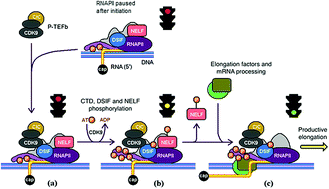The emerging picture of CDK9/P-TEFb: more than 20 years of advances since PITALRE
Abstract
CDK9 is a prominent member of the transcriptional CDKs subfamily, a group of kinases whose function is to control the primary steps of mRNA synthesis and processing by eukaryotic RNA polymerase II. As a cyclin-dependent kinase, CDK9 activation in vivo depends upon its association with T-type cyclins to assemble the positive transcription elongation factor (P-TEFb). Although CDK9/P-TEFb phosphorylates the C-terminal domain of RNAP II in the same positions targeted by CDK7 (TFIIH) and CDK8 (Mediator), the former does not participate in the transcription initiation, but rather plays a unique role by driving the polymerase to productive elongation. In addition to RNAP II CTD, the negative transcription elongation factors DSIF and NELF also represent major CDK9 substrates, whose phosphorylation is required to overcome the proximal pause of the polymerase. CDK9 is recruited to specific genes through proteins that interact with both P-TEFb and distinct elements in DNA, RNA or chromatin, where it modulates the activity of individual RNAP II transcription complexes. The regulation of CDK9 function is an intricate network that includes post-translational modifications (phosphorylation/dephosphorylation and acetylation/deacetylation of key residues) as well as the association of P-TEFb with various proteins that can stimulate or inhibit its kinase activity. Several cases of CDK9 deregulation have been linked to important human diseases, including various types of cancer and also AIDS (due to its essential role in HIV replication). Not only HIV, but also many other human viruses have been shown to depend strongly on CDK9 activity to be transcribed within host cells. This review summarizes the main advances made on CDK9/P-TEFb field in more than 20 years, introducing the structural, functional and genetic aspects that have been elucidated ever since.



 Please wait while we load your content...
Please wait while we load your content...